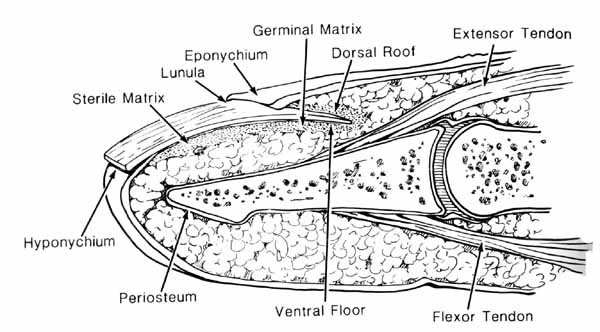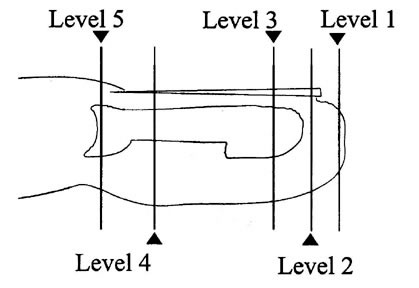Fingertip Amputations
Is This the Right Page for You?
First of all, you need to determine if this is the right page for you. This page covers fingerTIP amputations, not finger amputations and not fingertip crush injuries. The reason for the different pages is that they are treated in dramatically different ways.
Definitions
Fingertip amputations: part of your fingertip was cut off, but the last joint of your finger (the one next to the nail) is still there. This is the right page for you, keep reading. To start with, you can get a good idea of how great these injuries usually heal by looking at this video of the healing of the fingertip amputation of a surgeon.
Fingertip crush injuries: your fingertip was crushed, not cut, and essentially all the parts are still there, just mushed. This is NOT the right page for you, read Fingertip Crush Injuries here on my website.
Finger amputation: all or part of your finger (or hand or arm) was cut off, including the joint next to the tip of your finger. I do not have a page on this topic. These injuries may be considered for replantation with microsurgery.
Fingertip Anatomy
The fingertip is a highly specialized structure, with many specialized features. It has a lot of nerves, as I am sure you are more aware of than you would like! The illustration below shows many of the important structures of the fingertip. It is from the book, The Fingertip, by Dr. Zook.

The fingernail itself, the thing that you cut with a fingernail clipper, is called the nail plate. Underneath the nail plate is the nail bed, the mostly pink tissue you can see under the nail. It has several regions. The proximal (this is a medical term that is good to understand, it means that part closer to the heart; the opposite direction is called distal) part of the nail plate is called the germinal matrix. This is the part of the nail bed that originates the nail plate. When you look at your fingertip, part of the germinal matrix can be seen through the nail plate: it is the white moon-shaped area. The name for this is the lunula. That is, the lunula is the visible part of the germinal matrix. The majority of the germinal matrix is not visible, and it is located under the proximal nail fold, or eponychium. The cells of the dorsal roof in the eponychium are responsible for placing the shine on your nail plate. The hyponychium is a specialized structure uner the nail plate at the distal end. Its purpose is to help prevent dirt and bacteria from entering under the nail into the nail bed. It is backed by specialized capillaries (small arteries) and lymphatics that also help to prevent the invasion of bacteria or funger under the nail plate. The fingertip is also an organ of temperature regulation: if you are hot, special valves open up to allow increase bloodflow to your fingertips. If you are cold, these valves shut off (this explains why your fingertips get so cold in cold weather!) The fingertip is a very specialized structure!
Fingertip Amputation Injuries
There are many levels or kinds of fingertipamputations, as shown in the diagram below. This classification is called the Allen Classification, and is used for sharp amputations that are fairly straight across the finger. The classification breaks down when the cut is very oblique, for instance, removing all of the fingertip pad but none of the nailbed.

Level I involves only skin loss. Level II involves skin and nailbed. Level III also involves some loss of bone. Level IV involves loss of germinal matrix and often proximal nailfold. Level V invovles loss of the insertion of the tendon.
There are many other considerations besides just the level of the amputation. The nail bed can bleed, which creates a collection of blood (called a hematoma) under the nail plate. This is called a subungual hematoma. They can be very painful, and need to be drained. This usually dramatically decreases the pain of a fingertip injury. Fractures of the fingertip, usually of the type called a tuft fracture, usually heal well if given a chance to rest. A splint and rest is all that is needed.
How Are Fingertip Amputation Injuries Treated?
This is a great question, but the variety of injuries is so broad that it is hard to give you a specific answer. In general, fingertip amputations can be closed by taking part of the fingertip that was amputated, removing the bone and fat, and placing it back on the fingertip as a full-thickness skin graft. Most often, when the amputated part is not available to act as a skin donor, the would will be cleaned and covered with a special dressing called Tegaderm, which is a semipermeable membrane. This allows new skin to grow, nurtured by the healing fluids that accumulate under the dressing. Sometimes the open area is closed by moving some of the adjacent skin to close the wound. This is done particularly when there is a very large open wound and the amputated fingertip is not available. Each situation has unique characteristics, but this will give you an idea of the various options available to treat your injury.
What Kind of Results Can I Expect?
Almost all fingertip amputations start out looking horrible, and almost all of them result in a finger tip that is not normal, but is so highly functional that the patient has no disablity at all. Here are two examples. For a good example of healing, click on this https://e-hand.com/img/34984.htm.
